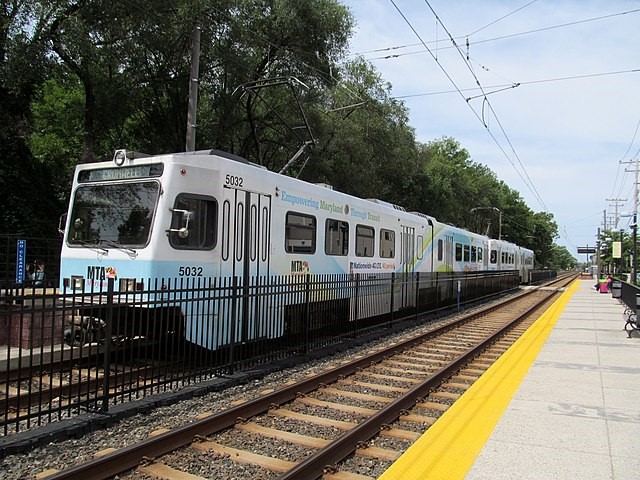
Although Baltimore’s light-rail system is capable of accommodating three-car trains, two cars are more common simply because ridership is so low. Photo by Pi.1415926535.
Baltimore’s Red Line: Insane or Idiotic?
Maryland transportation planners are considering spending a breathtaking $9 billion to build a 14-mile light-rail line that would never come close to carrying the 33,000 to 35,500 daily passengers they claim. This $640-million-per-mile cost would be incurred if they build the line in a tunnel. The alternative would be to build it on the surface, which is still projected to cost around $5 billion.
Underground trains could be faster because they wouldn’t have to deal with surface traffic, but they still wouldn’t be very fast. Based on Maryland Transit projections of how long it would take to go between various points on the light-rail line, the subway option would average 16 to 24 miles per hour while the surface option would average 12 to 14 miles per hour.
Due to the higher speeds, state officials project the subway option will attract more riders — but not a lot more riders. The surface option is projected to carry 28,500 to 31,500 daily riders. Spending 80 percent more on a tunnel would increase ridership by only about 15 percent.
None of these ridership numbers are believable anyway. Baltimore currently has 30 miles of light-rail lines that carried fewer than 22,000 daily riders in 2019 and fewer than 9,000 in 2023. It is highly unlikely that adding 14 more miles would quadruple ridership.
The Red Line’s supposed virtue is that it would serve low-income neighborhoods. But only 7.6 percent of residents of the Baltimore urban area who earn under $25,000 a year take transit to work compared with 72 percent who drive alone and another 10 percent who carpool. Putting far less money into vanpooling would do far more to help low-income people and relieve congestion.
Maryland has a long history of overestimating rail transit ridership. Baltimore’s first rail transit line, a true heavy-rail subway, was projected to carry 138 percent more riders than it did. Projections for the city’s light-rail lines have been averaged about 50 percent more riders than they actually carried. The Red Line, if it is built, will far exceed that because it is clear that the projections are ignoring the effects of the pandemic, including the loss of downtown jobs.
Regardless of projections, the riders carried by previous Baltimore light- and heavy-rail lines were completely offset by the loss of Baltimore bus ridership, probably because cost overruns forced cutbacks in bus service. Total transit ridership was lower in 2019 than it had been before any of the rail lines were built. Baltimore buses carried more than 122 million riders in 1982, the year before the Baltimore subway opened. As of 2019, Baltimore buses, light rail, and heavy rail together carried just 78 million riders. That’s hardly an endorsement for spending billions on another rail line.
Downtown Baltimore only contained about 6 percent of the region’s jobs before the pandemic. According to American Community Survey data, more than 20 percent of downtown workers took transit to work before the pandemic, but less than 7 percent of non-downtown workers in the Baltimore urban area commuted by transit. As with so many other transit systems, Maryland is pointlessly focused on downtown even though more than 90 percent of people work elsewhere.
In addition to overestimating ridership, it should not be surprising that Maryland tends to underestimate costs. Baltimore’s subway line cost 60 percent more than projected. The most recent light-rail project cost 42 percent more. Of course, Maryland’s Purple Line, in the DC suburbs, has already cost about three times the original projection.
The earliest projected cost I can find for the Red Line was $2.2 billion in 2011. While there has been some inflation since then, that wouldn’t account for a more than doubling of the cost of a surface line. At the time that projection was made, the Purple Line was projected to cost $1.9 billion; currently construction is projected to cost $5.7 billion and it will probably cost more.
Many of the officials quoted in news reports about the Red Line say it is needed to deal with Baltimore congestion, with some comparing the proposed light-rail subway with the Washington Metro system. But light rail simply does not have the capacity to move enough people to relieve congestion even if they could fill the trains, which is unlikely. Baltimore’s light-rail cars are rated to hold 176 people, so three-car trains running every three minutes would move about 10,560 people per hour. Washington’s subway cars can hold 187 people and operate in eight-car trains, so can move nearly three times as many people per hour as the Baltimore subway.
Needless to say, even though Baltimore’s light-rail cars are rated to carry 176 passengers, they never do. The average number of passengers carried in 2019 was less than 20. While cars will be fuller during rush hours, the 176-passenger number is “crush capacity,” and Americans will not put up with being crammed into trains the way Japanese or Chinese trains are filled.
Even if ridership projections were believable, spending $5 billion to get 30,000 riders is insane. Spending $4 billion more to get 15 percent more riders is idiotic. Yet I won’t be surprised if Maryland officials pick the more expensive option.
Maryland and Baltimore officials are crazy to think that the ridership numbers projected for the Red Line are realistic; that it would make sense to spend $5 billion, much less $9 billion, for a 14-mile light-rail line; or that such a line would do anything to relieve traffic congestion. As in the case of Charlotte’s Red Line, this is a clear example of politicians putting patronage and pork barrel ahead of the actual needs of transportation users.
Note: Originally published at The Antiplanner on October 25, 2024.





